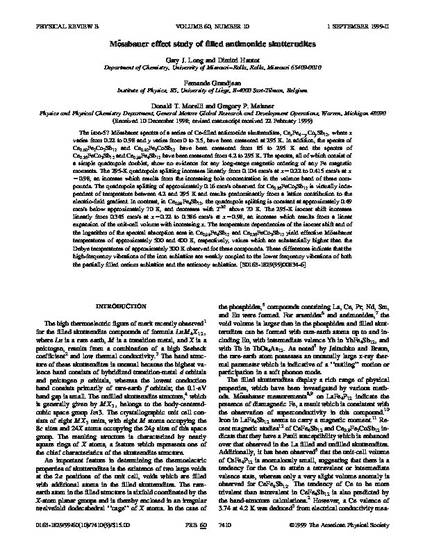
The iron-57 Mössbauer spectra of a series of Ce-filled antimonide skutterudites, CexFe4-yCoySb12, where x varies from 0.22 to 0.98 and y varies from 0 to 3.5, have been measured at 295 K. In addition, the spectra of Ce0.60Fe2Co2Sb12 and Ce0.82Fe3CoSb12 have been measured from 85 to 295 K and the spectra of Ce0.35FeCo3Sb12 and Ce0.98Fe4Sb12 have been measured from 4.2 to 295 K. The spectra, all of which consist of a simple quadrupole doublet, show no evidence for any long-range magnetic ordering of any Fe magnetic moments. The 295-K quadrupole splitting increases linearly from 0.104 mm/s at x=0.22 to 0.415 mm/s at x =0.98, an increase which results from the increasing hole concentration in the valence band of these compounds. The quadrupole splitting of approximately 0.16 mm/s observed for Ce0.35FeCo3Sb12 is virtually independent of temperature between 4.2 and 295 K and results predominantly from a lattice contribution to the electric-field gradient. In contrast, in Ce0.98Fe4Sb12, the quadrupole splitting is constant at approximately 0.49 mm/s below approximately 70 K, and decreases with T3/2 above 70 K. The 295-K isomer shift increases linearly from 0.345 mm/s at x=0.22 to 0.386 mm/s at x=0.98, an increase which results from a linear expansion of the unit-cell volume with increasing x. The temperature dependencies of the isomer shift and of the logarithm of the spectral absorption area in Ce0.98Fe4Sb12 and Ce0.35FeCo3Sb12 yield effective Mössbauer temperatures of approximately 500 and 400 K, respectively, values which are substantially higher than the Debye temperatures of approximately 300 K observed for these compounds. These differences indicate that the high-frequency vibrations of the iron sublattice are weakly coupled to the lower frequency vibrations of both the partially filled cerium sublattice and the antimony sublattice.
- Antimonide,
- Mössbauer spectroscopy,
- Skutterudite
Available at: http://works.bepress.com/gary-long/223/
